Dissipation Theory-Based Ecological Protection and Restoration Scheme Construction for Reclamation Projects and Adjacent Marine Ecosystems
Abstract
1. Introduction
2. Materials and Methods
2.1. Study Area
2.2. Research Methods
2.2.1. Dissipative Structure and Establishment of Entropy Model
2.2.2. Analytic Hierarchy Process
- (1)
- Establishment of a hierarchical structure model:
- (2)
- Construction of a comparison discriminant matrix:
- (3)
- Consistency test:
3. Results
3.1. Main Form of Entropy Increase of Reclamation Project and Adjacent Marine Ecological Environment
3.1.1. Entropy Increases in Resources: Reduced Wetland Area and Loss of Biological Resources
3.1.2. Entropy Increases in Environment: Soil Erosion, Near-Shore Pollution, and Reduced Environmental Capacity
3.1.3. Entropy Increases in Landscape: Poor Public-Service Function and Landscape Effect
3.2. Relative Importance of Calculating Negative Entropy Flow by Analytic Hierarchy Process (AHP)
- (1)
- BW1: water system recovery > mangrove planting > returning beach from fish farming > returning wetland from farmland > control to alien species;
- (2)
- BW2: sandbeach conservation > artificial ecological revetment > vegetation planting > promoting siltation and maintaining siltbeach;
- (3)
- BW3: proliferation and release marine life > artificial fish reef > large algae cultivation;
- (4)
- BW4: reclaimed water reuse > sewage centralized treatment > sea-drifting garbage collection.
3.3. Main Ecological Restoration Scheme for Reclamation Projects and Adjacent Marine Ecosystems
3.3.1. Negative Entropy Flow of Resources: Ecological Restoration of Wetland Systems
- (1)
- Restoration of the water system:
- (2)
- Mangrove ecological wetland area:
3.3.2. Negative Entropy Flow of Landscape: Ecological Seawall Construction to Improve Landscapes
- (1)
- Sandbeach shoreline:
- (2)
- Artificial ecological revetment and vegetation planting
3.3.3. Environmental Negative Entropy Flow: Pollution Prevention
3.3.4. Bio-Ecological Negative Entropy Flow: Restoration of Marine Living Resources
4. Discussion
5. Conclusions
Author Contributions
Funding
Conflicts of Interest
References
- Calder, R.S.D.; Shi, C.J.; Mason, S.A.; Olander, L.P.; Borsuk, M.E. Forecasting ecosystem services to guide coastal wetland rehabilitation decisions. Ecosyst. Serv. 2019, 39, 101007. (In Chinese) [Google Scholar] [CrossRef]
- Yang, W.; Jin, Y.W.; Sun, T.; Yang, Z.F.; Cai, Y.P.; Yi, Y.J. Trade-offs among ecosystem services in coastal wetlands under the effects of reclamation activities. Ecol. Indic. 2018, 92, 354–366. [Google Scholar] [CrossRef]
- Ministry of Natural Resources. The First National Marine Inspector Was Officially Launched. Available online: http://gtfwj.dl.gov.cn/info/43800_251170.vm (accessed on 8 January 2019). (In Chinese)
- Ministry of Natural Resources. The National Marine Inspectorate Group Reported to Liaoning on the Special Inspection of Reclamation. Available online: http://www.mnr.gov.cn/zt/hy/2017wthzxdc/xwzx/201801/t20180114_2102459.html (accessed on 8 January 2019). (In Chinese)
- Ministry of Natural Resources. The National Marine Inspectorate Group Provides Regular Inspectors and Special Inspections for Reclamation in Hebei. Available online: http://www.mnr.gov.cn/zt/hy/2017wthzxdc/xwzx/201801/t20180116_2102462.html (accessed on 8 January 2019). (In Chinese)
- Ministry of Natural Resources. The National Marine Inspectorate Group Sent Feedback to Tianjin on the Special Inspection of the Reclamation. Available online: http://www.mnr.gov.cn/dt/zb/2018/2018bhsd/beijingziliao/201807/t20180709_2183957.html (accessed on 8 January 2019). (In Chinese)
- Ministry of Natural Resources. National Ocean Inspector Group: There Are Four Major Problems in Shandong Ocean Work. Available online: http://www.mnr.gov.cn/dt/mtsy/201807/t20180705_2328845.html (accessed on 8 January 2019). (In Chinese)
- Ministry of Natural Resources. The National Marine Inspectorate Group Reports to Jiangsu on the Special Inspection of Reclamation. Available online: http://www.mnr.gov.cn/zt/hy/2017wthzxdc/xwzx/201801/t20180114_2102458.html (accessed on 8 January 2019). (In Chinese)
- Ministry of Natural Resources. The National Marine Inspectorate Group Sent Feedback to the Special Inspection of the Reclamation in Zhejiang. Available online: http://www.mnr.gov.cn/dt/zb/2018/2018bhsd/beijingziliao/201807/t20180705_2183956.html (accessed on 8 January 2019). (In Chinese)
- Ministry of Natural Resources. The National Marine Inspectorate Group Reports to Guangdong on Routine Inspections and Special Inspections on Reclamation. Available online: http://www.mnr.gov.cn/dt/zb/2018/2018bhsd/beijingziliao/201807/t20180703_2183953.html (accessed on 8 January 2019). (In Chinese)
- Ministry of Natural Resources. National Ocean Inspector Group. The Four Major Issues of Guangxi Reclamation Control Cannot Be Ignored. Available online: http://www.mnr.gov.cn/zt/hy/2017wthzxdc/mtbd/201801/t20180116_2102486.html (accessed on 8 January 2019). (In Chinese)
- State Council. Notice of the State Council on Strengthening the Protection of Coastal Wetlands and Strictly Controlling the Reclamation; State Council: Beijing, China, 2018. (In Chinese) [Google Scholar]
- Ministry of Natural Resources. Notice on Further Addressing the Relevant Requirements for the Remaining Issues Concerning the Reclamation of the Reclamation (Natural Resources [2018] No. 7). Available online: http://www.gov.cn/xinwen/2019-01/08/content_5355787.htm (accessed on 11 January 2019). (In Chinese)
- Ministry of Natural Resources. Technical Guidelines for the Preparation of Ecological Protection and Restoration Program for Reclamation Projects (Trial); Ministry of Natural Resources: Beijing, China, 2018. (In Chinese) [Google Scholar]
- Wu, J.C. Island Ecological Restoration and Environmental Protection; China Ocean Press: Bejing, China, 2013. (In Chinese) [Google Scholar]
- Jenssen, M. Ecological potentials of biodiversity modelled from information entropies: Plant species diversity of North-Central European forests as an example. Ecol. Inform. 2007, 2, 328–336. [Google Scholar] [CrossRef]
- Ludovisi, A. Effectiveness of entropy-based functions in the analysis of ecosystem state and development. Ecol. Indic. 2014, 36, 617–623. [Google Scholar] [CrossRef]
- Zhang, Y.; Yang, Z.; Li, W. Analyses of urban ecosystem based on information entropy. Ecol. Model. 2006, 197, 1–12. [Google Scholar] [CrossRef]
- Di, G.B.; Han, Y.Q. Analysis of the sustainable development capacity of China’s marine ecosystem from the perspective of entropy. Geogr. Sci. 2014, 34, 664–671. (In Chinese) [Google Scholar]
- Wang, Y.M.; Wang, X.; Zhang, S.; Ding, J.X. Analysis of sustainable development of regional human-sea complex ecosystem based on information entropy. Soil Water Conserv. Res. 2018, 25, 332–338. (In Chinese) [Google Scholar]
- Xu, S.; Xu, D.; Liu, L. Construction of regional informatization ecological environment based on the entropy weight modified AHP hierarchy model. Sustain. Comput. 2019, 22, 26–31. [Google Scholar] [CrossRef]
- Zhou, Y.J.; Zhou, J.X.; Liu, H.L.; Xia, M. Study on eco-compensation standard for adjacent administrative districts based on the maximum entropy production. J. Clean Prod. 2019, 221, 644–655. [Google Scholar] [CrossRef]
- Beronvera, F.J.; Olascoaga, M.J.; Haller, G.; Farazmand, M.; Triñanes, J.; Wang, Y. Dissipative inertial transport patterns near coherent Lagrangian eddies in the ocean. Chaos 2015, 25, 087412. [Google Scholar] [CrossRef] [PubMed]
- Goldbeter, A. Dissipative structures and biological rhythms. Chaos 2017, 27, 104612. [Google Scholar] [CrossRef] [PubMed]
- Shannon, C.E. A mathematical theory of communication. Bell Syst. Tech. J. 1948, 27, 379–423. [Google Scholar] [CrossRef]
- Jürgen, K. A mathematical theory of communication: Meaning, information, and topology. Complexity 2011, 16, 10–26. [Google Scholar]
- Aoki, I. Ecological pyramid of dissipation function and entropy production in aquatic ecosystems. Ecol. Complex. 2006, 3, 104–108. [Google Scholar] [CrossRef]
- Miotto, M.; Monacelli, L. Entropy evaluation sheds light on ecosystem complexity. Phys. Rev. 2018, 98, 042402. [Google Scholar] [CrossRef]
- Zhao, J.C.; Ji, G.X.; Tian, Y.; Chen, Y.L.; Wang, Z. Environmental vulnerability assessment for mainland China based on entropy method. Ecol. Indic. 2018, 91, 410–422. [Google Scholar] [CrossRef]
- He, L.; Zhou, G.H. Analysis into development of pastoral complex based on dissipative structure theory. Acta Agric. Zhejiangensis 2019, 31, 1388–1398. [Google Scholar]
- Saaty, T.L.; Vargas, L.G. Models, methods, concepts & applications of the analytic hierarchy process. International 2017, 7, 159–172. [Google Scholar]
- Saaty, T.L. Fundamentals of the Analytic Hierarchy Process. In The Analytic Hierarchy Process in Natural Resource and Environmental Decision Making; Springer: Dordrecht, The Netherlands, 2001; Volume 3. [Google Scholar]
- Satty, T.L. Analytic Hierarchy Process. Encyclopedia of Biostatistics; John Wiley & Sons, Ltd.: Hoboken, NJ, USA, 2005. [Google Scholar]
- Liang, Z.X.; Li, W. Evaluation of ecological environment tourism resource based on AHP method and countermeasure research of Yanhu district Yuncheng City. Sichuan Environ. 2017, 36, 91–96. (In Chinese) [Google Scholar]
- Fan, C.H. Discussion on the feasibility of various forms of fluvial cross section in northen cities. China Water Transp. 2014, 14, 288–289. (In Chinese) [Google Scholar]
- Zhang, X.F.; Wang, Y.L.; Li, Z.G.; Li, W.F. Relationship between soil bareness and landscape pattern in the Loess Plateau: A case study on the tower region of the Yan’an City. Quat. Sci. 2004, 24, 709–715. (In Chinese) [Google Scholar]
- Xing, Y.; Wang, B.; Bian, Q.Q. Research on Urban Waterfront Spatial Planning from the Perspective of Public Demand: A Case Study of Haihe Bund Area in Tianjin Binhai New Area. In Proceedings of the Annual Conference on Urban. Planning in China, Guiyang, China, 19 September 2015. (In Chinese). [Google Scholar]
- Sun, S.; Wang, B. Study on ecological restoration technology of Yanxi River wetland in Beijing. Energy Procedia 2018, 153, 330–333. [Google Scholar] [CrossRef]
- Mao, X.F.; Wei, X.Y.; Jin, X.; Tao, Y.Q.; Zhang, Z.F.; Wang, W.Y. Monitoring urban wetlands restoration in Qinghai Plateau: Integrated performance from ecological characters, ecological processes to ecosystem services. Ecol. Indic. 2019, 101, 623–631. [Google Scholar] [CrossRef]
- Das, S. Ecological Restoration and Livelihood: Contribution of Planted Mangroves as Nursery and Habitat for Artisanal and Commercial Fishery. World Dev. 2017, 94, 492–502. [Google Scholar] [CrossRef]
- Hein, M.Y.; Birtles, A.; Willis, B.L.; Gardiner, N.; Beeden, R.; Marshall, N.A. Coral restoration: Socio-ecological perspectives of benefits and limitations. Biol. Conserv. 2019, 229, 14–25. [Google Scholar] [CrossRef]
- Pueyo-Ros, J.; Garcia, X.; Ribas, A.; Fraguell, R.M. Ecological restoration of a coastal wetland at a mass tourism destination. Will the recreational value increase or decrease. Ecol. Econ. 2018, 148, 1–14. [Google Scholar] [CrossRef]

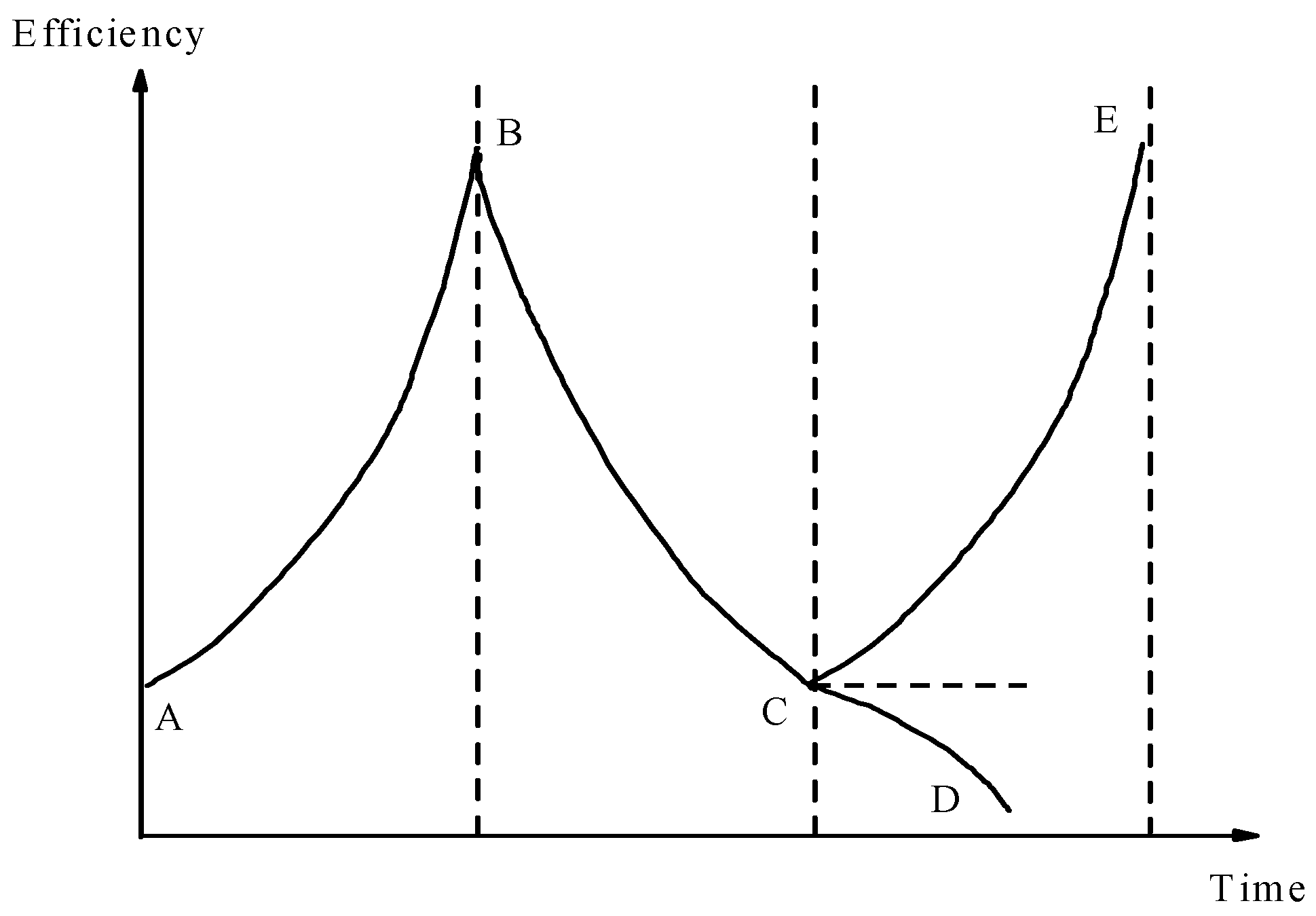
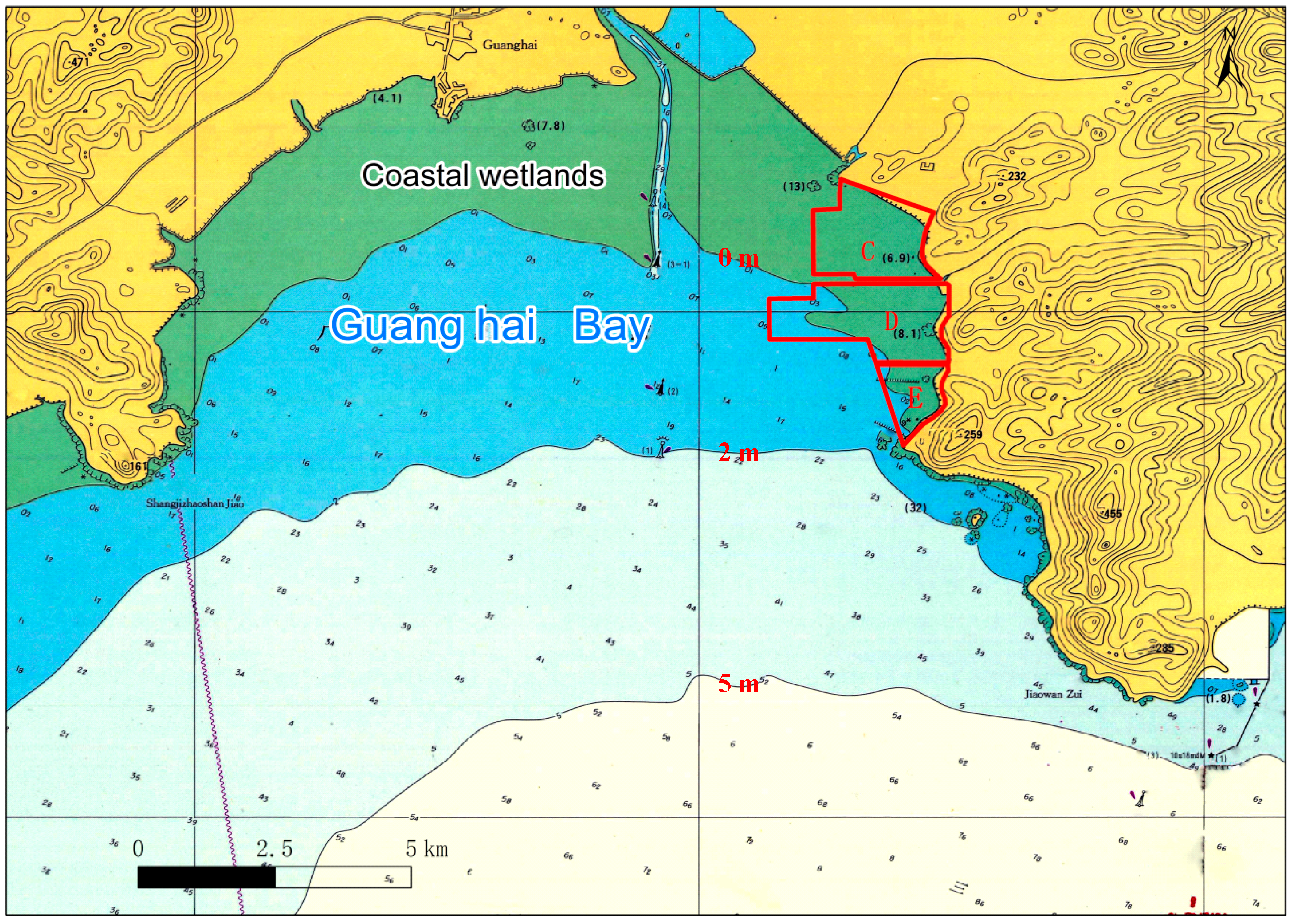
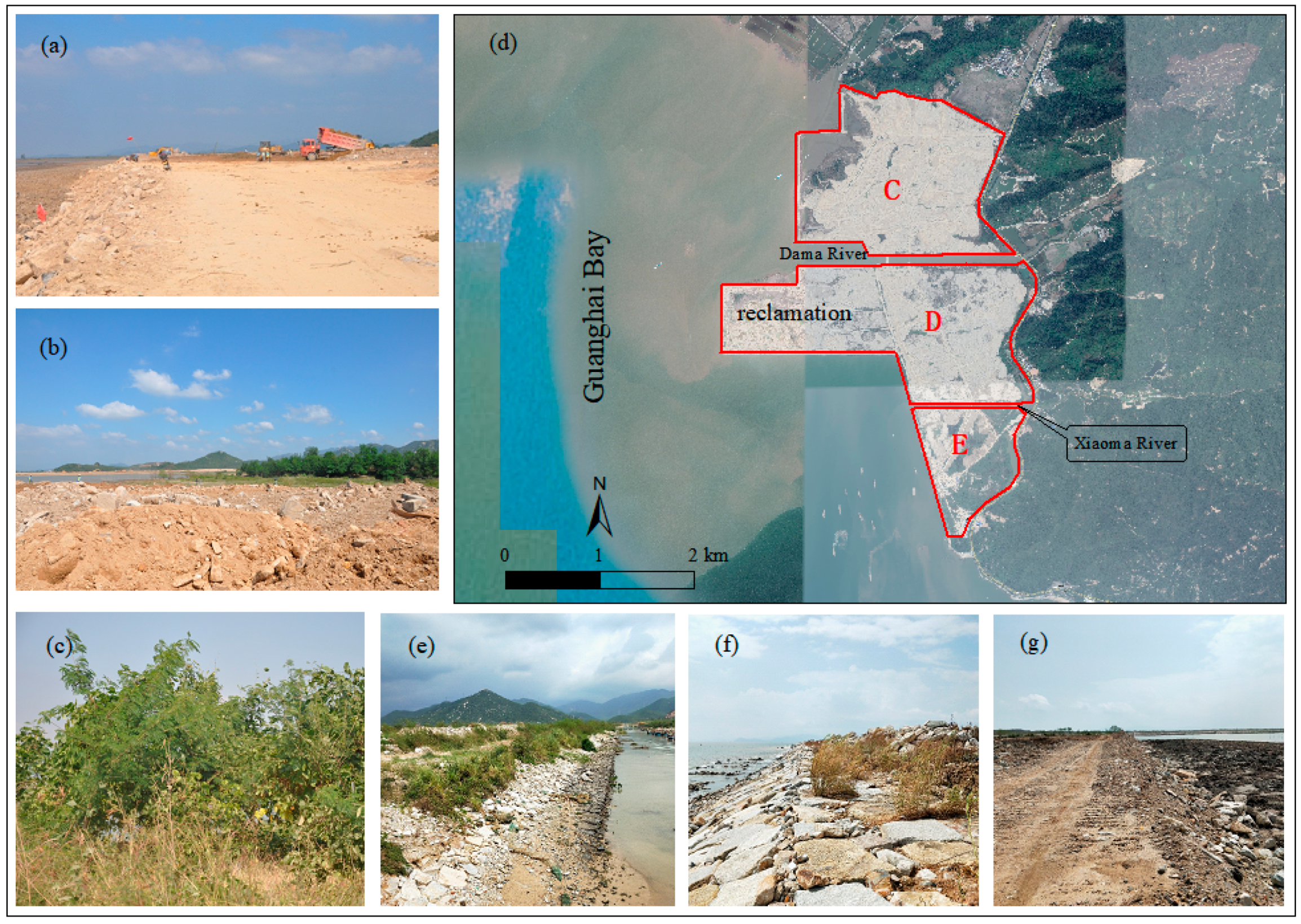

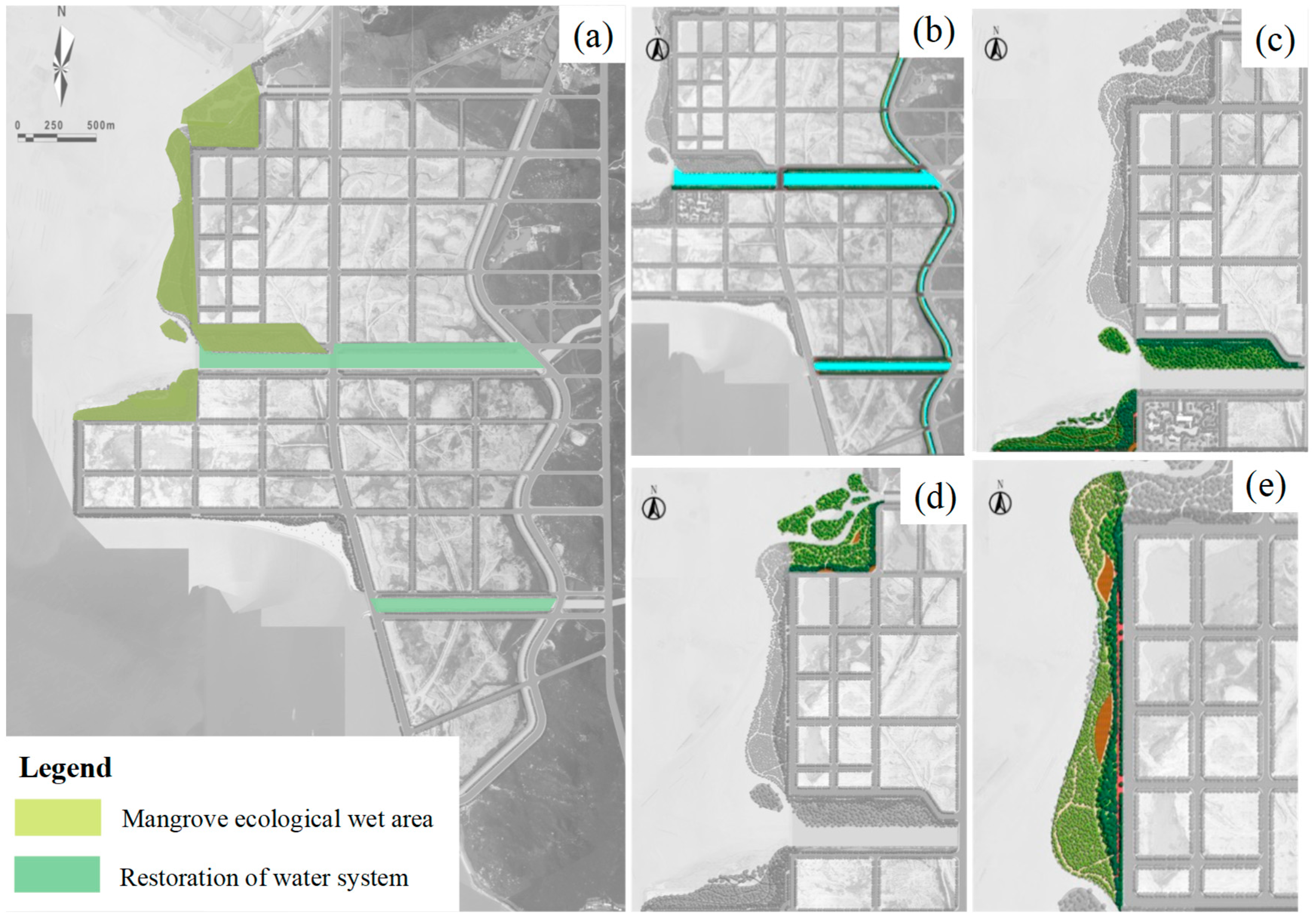
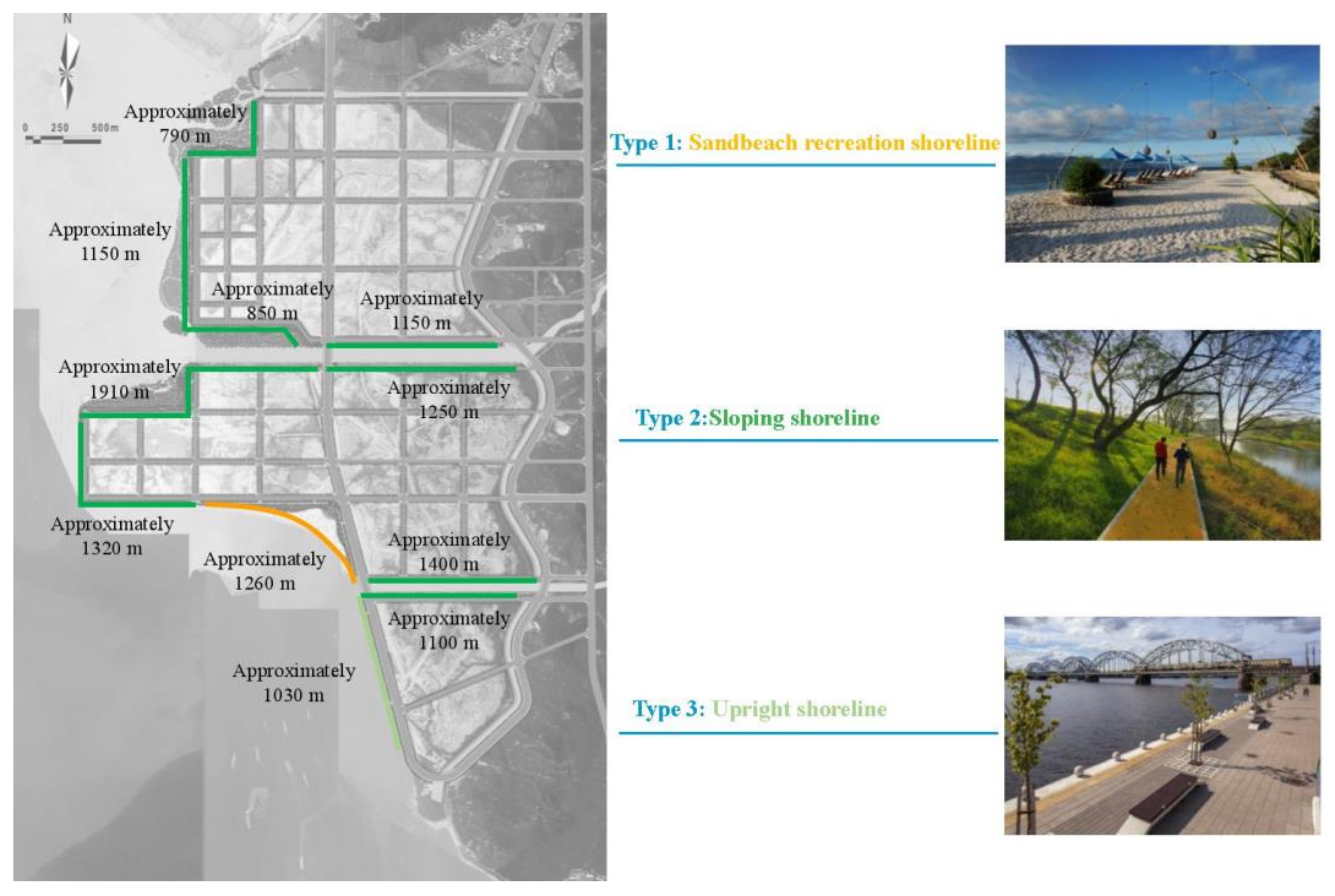
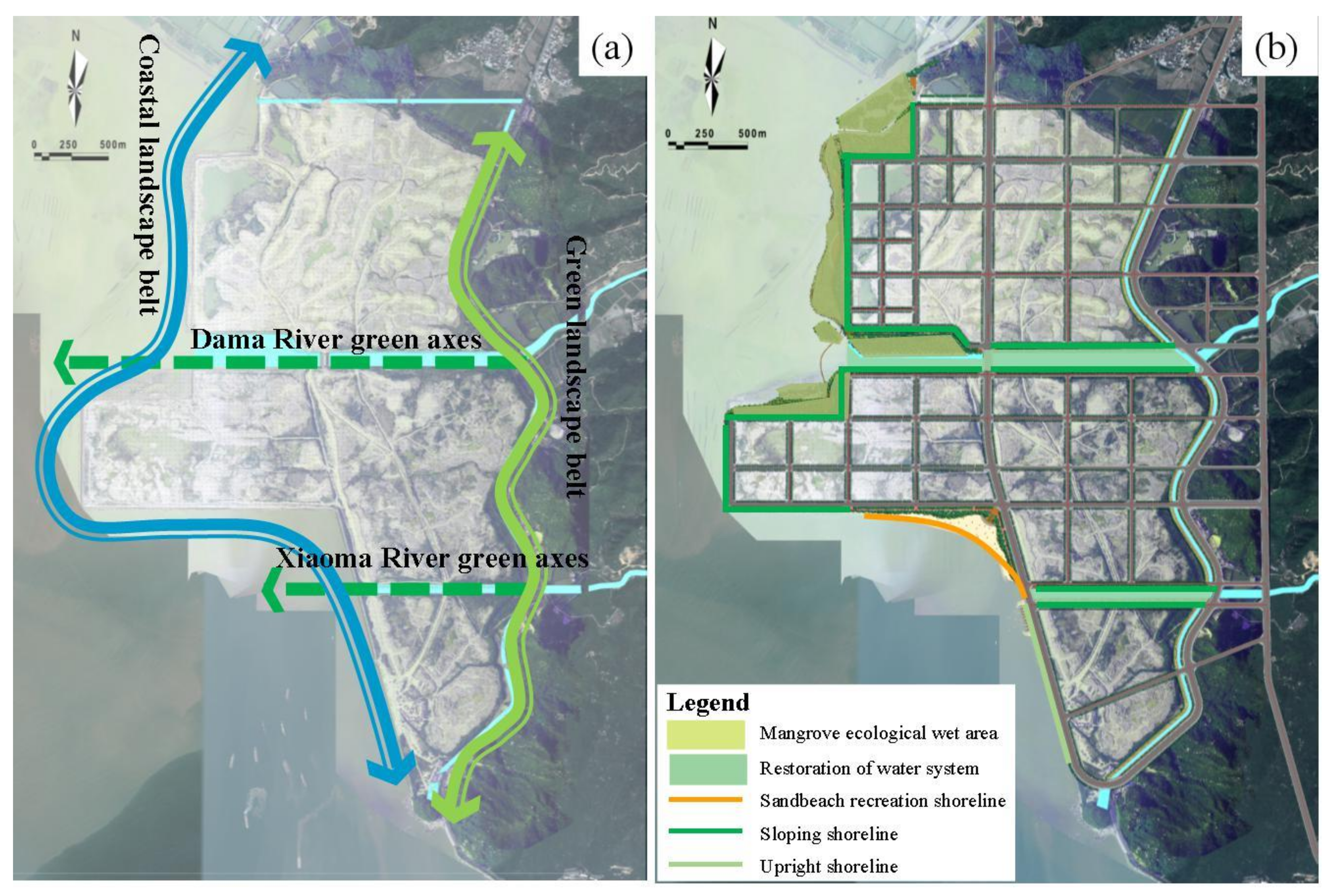

| Element | Scaling | Value Rule (a Factor in the Above Layer is the Criterion, and at the Current Level, Factor i is Compared with Factor j) |
|---|---|---|
| aij | 1 | Equally important |
| 3 | i is slightly more important than j | |
| 5 | i is more important than j | |
| 7 | i is more important than j | |
| 9 | i is extremely more important than j | |
| 2, 4, 6, 8 | Comparison between the importance of the two factors i and j is in the middle of the above results | |
| aji | Reciprocal | Comparison between the importance of factors i and j is the reciprocal of the comparison between their importance |
| n | 1 | 2 | 3 | 4 | 5 | 6 | 7 | 8 | 9 |
|---|---|---|---|---|---|---|---|---|---|
| RI | 0 | 0 | 0.58 | 0.94 | 1.12 | 1.24 | 1.32 | 1.41 | 1.45 |
| Matrix | n | Hierarchical Single-Sorted Weight Vector (W) | Maximum Eigenvalue (λmax) | Average Random Consistency Indicator (RI) | Consistency Indicator (CI) | Consistency Ratio (CR) | Acceptable Consistency |
|---|---|---|---|---|---|---|---|
| AW | 4 | (0.4824, 0.2718, 0.0883, 0.1575) | 4.015 | 1.12 | 0.005 | 0.004 | Yes |
| BW1 | 5 | (0.4461, 0.2864, 0.1567, 0.0716, 0.0392) | 5.050 | 1.12 | 0.042 | 0.034 | Yes |
| BW2 | 4 | (0.4758, 0.2884, 0.1544, 0.0813) | 4.021 | 0.94 | 0.007 | 0.007 | Yes |
| BW3 | 3 | (0.5390, 0.2973, 0.1638) | 3.009 | 0.58 | 0.004 | 0.008 | Yes |
| BW4 | 3 | (0.5390, 0.2973, 0.1638) | 3.009 | 0.58 | 0.004 | 0.008 | Yes |
© 2019 by the authors. Licensee MDPI, Basel, Switzerland. This article is an open access article distributed under the terms and conditions of the Creative Commons Attribution (CC BY) license (http://creativecommons.org/licenses/by/4.0/).
Share and Cite
Huang, F.; Lin, Y.; Zhao, R.; Qin, X.; Chen, Q.; Lin, J. Dissipation Theory-Based Ecological Protection and Restoration Scheme Construction for Reclamation Projects and Adjacent Marine Ecosystems. Int. J. Environ. Res. Public Health 2019, 16, 4303. https://doi.org/10.3390/ijerph16214303
Huang F, Lin Y, Zhao R, Qin X, Chen Q, Lin J. Dissipation Theory-Based Ecological Protection and Restoration Scheme Construction for Reclamation Projects and Adjacent Marine Ecosystems. International Journal of Environmental Research and Public Health. 2019; 16(21):4303. https://doi.org/10.3390/ijerph16214303
Chicago/Turabian StyleHuang, Faming, Yanhong Lin, Rongrong Zhao, Xuan Qin, Qiuming Chen, and Jie Lin. 2019. "Dissipation Theory-Based Ecological Protection and Restoration Scheme Construction for Reclamation Projects and Adjacent Marine Ecosystems" International Journal of Environmental Research and Public Health 16, no. 21: 4303. https://doi.org/10.3390/ijerph16214303
APA StyleHuang, F., Lin, Y., Zhao, R., Qin, X., Chen, Q., & Lin, J. (2019). Dissipation Theory-Based Ecological Protection and Restoration Scheme Construction for Reclamation Projects and Adjacent Marine Ecosystems. International Journal of Environmental Research and Public Health, 16(21), 4303. https://doi.org/10.3390/ijerph16214303





